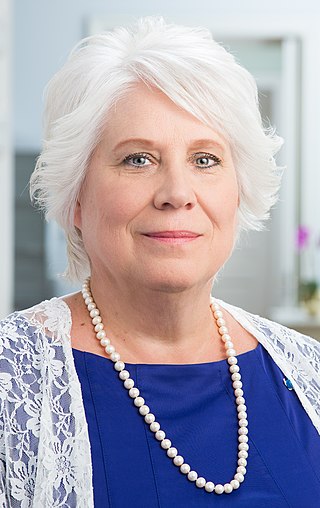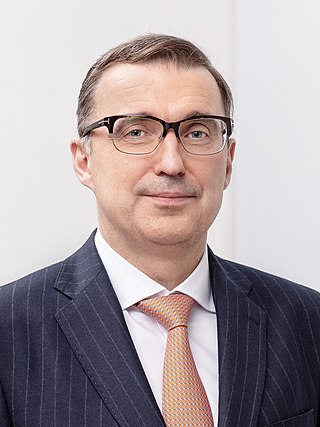The Republic of Estonia gained its independence from the Russian Empire on 24 February 1918 and established diplomatic relations with many countries via membership of the League of Nations. The forcible incorporation of Estonia into the Soviet Union in 1940 was not generally recognised by the international community and the Estonian diplomatic service continued to operate in some countries. Following the restoration of independence from the Soviet Union, Russia was one of the first nations to re-recognize Estonia's independence. Estonia's immediate priority after regaining its independence was the withdrawal of Russian forces from Estonian territory. In August 1994, this was completed. However, relations with Moscow have remained strained primarily because Russia decided not to ratify the border treaty it had signed with Estonia in 1999.

Juhan Parts ( is an Estonian politician who was Prime Minister of Estonia from 2003 to 2005 and Minister of Economic Affairs and Communications from 2007 to 2014. Juhan Parts is a member of Isamaa party.

Tarkhuna or Tarkhun is a Georgian carbonated soft drink that is flavored with tarragon or woodruff. It was first created in the Kutais Governorate of the Russian Empire in 1887, by a young Georgian pharmacist named Mitrofan Lagidze in the city of Kutaisi. Mitrofan Lagidze began to add odorous chukhpuch containing extract of Caucasian tarragon to sparkling water with natural syrups of his own production. Before the First World War, Lagidze repeatedly received gold medals at international exhibitions for his water. In 1927, the Soviet authorities built a plant for the production of "Lagidze water" in Tbilisi, and Lagidze himself was appointed director.
The Minister of Education and Research is the senior minister at the Ministry of Education and Research in the Estonian Government. The Minister is responsible for administration and development of Estonian educational system as well as for administration and funding of research and development activities on national level.
A Ministry of Economy, Ministry of Commerce, Ministry of Economic Affairs, or Department of Commerce is a part of the government in most countries that is responsible for matters related to the economy or economic policy.

Marina Kaljurand is an Estonian politician and Member of the European Parliament. Kaljurand served as Minister of Foreign Affairs in Taavi Rõivas' second cabinet as an independent. Earlier, she served as the Ambassador of Estonia to the United States, Russia, Mexico, Canada, Kazakhstan, and Israel.

The Helsinki–Tallinn Tunnel is a proposed undersea tunnel that would span the Gulf of Finland and connect the Finnish and Estonian capitals by train. The tunnel's length would depend upon the route taken: the shortest distance across would have a submarine length of 80 kilometres (50 mi), which would make it 40% longer than the current longest railway tunnel in the world, the 57 km Gotthard Base Tunnel. It has been estimated that the tunnel, if constructed, will cost €9–13 billion. It may open in the 2030s. The European Union has approved €3.1 million in funding for feasibility studies. A pre-feasibility study from 2015 proposed a 250 km/h top speed.

Foreign relations exist between Australia and Estonia. Australia first recognised Estonia on 22 September 1921. Australia was among the first countries to re-recognise Estonia's independence on 27 August 1991. Both countries re-established diplomatic relations on 21 November 1991.

The Ministry of Economic Affairs and Communications is a government ministry of Estonia. Its head office is in Tallinn.

e-Residency of Estonia is a program launched by Estonia on 1 December 2014. The program allows non-Estonians access to Estonian services such as company formation, banking, payment processing, and taxation. The program gives the e-resident a smart card which they can use to sign documents. The program is aimed towards location-independent entrepreneurs such as software developers and writers. The first e-resident of Estonia was British journalist Edward Lucas; the first person to apply for and be granted e-residency through the standard process was Hamid Tahsildoost from the United States.
The Minister of Entrepreneurship and Information Technology of Estonia was a minister at the Ministry of Economic Affairs and Communications in the Estonian Government.
The Ministry of Regional Affairs and Agriculture is a government ministry of Estonia responsible for policies regarding agriculture, food market and food safety, animal health, welfare and breeding, bioeconomy and fishing industry in Estonia. The ministry is headed by Minister of Regional Affairs and Agriculture, who is currently Piret Hartman.

TS Laevad is an Estonian ferry company which operates two routes between the Estonian mainland and the islands of Hiiumaa and Muhu in the Baltic Sea. Muhu is connected by a causeway to Estonia's largest island, Saaremaa.
Estonian Safety Investigation Bureau is the transport safety agency of Estonia, headquartered in Tallinn. It is under the Ministry of Economic Affairs and Communications. It investigates aviation, maritime, and rail accidents.

Jüri Ratas's second cabinet was the 50th cabinet of Estonia, in office from 29 April 2019 to 14 January 2021. It was a centre-right coalition cabinet of the Centre Party, right-wing populist Conservative People's Party (EKRE) and conservative Isamaa.

Andres Sutt is an Estonian politician. He served as Minister of Entrepreneurship and Information Technology in the cabinet of Prime Minister Kaja Kallas. He served as acting Minister of Foreign Affairs from June to July 2022.
Liina Tõnisson is an Estonian politician. She has been a member of VII, VIII, IX, X and XI Riigikogu.

Tourism in Estonia refers to the overall state of the tourism industry in the Finno-Ugric nation of Estonia. It is a key part of the country's economy, contributing 7.8% to its GDP, and employing 4.3% of its population. In 2018, tourism and other related services counted for over 10.8 percent of Estonia's exports. Tourism is increasing rapidly in Estonia: the number of tourist arrivals—both domestic and international—has increased from 2.26 million in 2006 to 3.79 million in 2019. Estonia was also ranked the 15th-most safest country to visit in 2017, according to safedestinations.com, scoring 8.94 out of 10 on their list. In a 2018 report published by the OECD, they concluded that most international tourists come from places like Finland, Russia, Latvia, Germany, and Sweden.

Liisa Past is an Estonian civil servant, political, communication and cyber security expert.
















